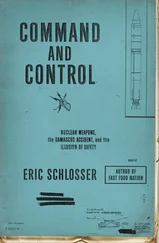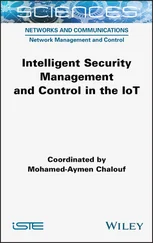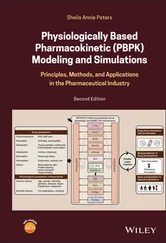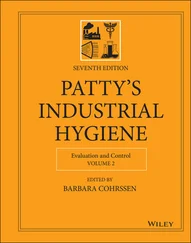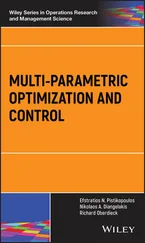Robot Modeling and Control
Second Edition
Mark W. Spong
Seth Hutchinson
M. Vidyasagar

This edition first published 2020
© 2020 John Wiley & Sons, Ltd
Edition History
John Wiley & Sons, Ltd (1e, 2006)
All rights reserved. No part of this publication may be reproduced, stored in a retrieval system, or transmitted, in any form or by any means, electronic, mechanical, photocopying, recording or otherwise, except as permitted by law. Advice on how to obtain permission to reuse material from this title is available at http://www.wiley.com/go/permissions.
The right of Mark W. Spong, Seth Hutchinson and M. Vidyasagar to be identified as the author(s) of this work has been asserted in accordance with law.
Registered Office(s)
John Wiley & Sons, Inc., 111 River Street, Hoboken, NJ 07030, USA
John Wiley & Sons Ltd, The Atrium, Southern Gate, Chichester, West Sussex, PO19 8SQ, UK
Editorial Office
John Wiley & Sons Ltd, The Atrium, Southern Gate, Chichester, West Sussex, PO19 8SQ, UK
For details of our global editorial offices, customer services, and more information about Wiley products visit us at www.wiley.com.
Wiley also publishes its books in a variety of electronic formats and by print-on-demand. Some content that appears in standard print versions of this book may not be available in other formats.
Limit of Liability/Disclaimer of Warranty
The contents of this work are intended to further general scientific research, understanding, and discussion only and are not intended and should not be relied upon as recommending or promoting scientific method, diagnosis, or treatment by physicians for any particular patient. In view of ongoing research, equipment modifications, changes in governmental regulations, and the constant flow of information relating to the use of medicines, equipment, and devices, the reader is urged to review and evaluate the information provided in the package insert or instructions for each medicine, equipment, or device for, among other things, any changes in the instructions or indication of usage and for added warnings and precautions. While the publisher and authors have used their best efforts in preparing this work, they make no representations or warranties with respect to the accuracy or completeness of the contents of this work and specifically disclaim all warranties, including without limitation any implied warranties of merchantability or fitness for a particular purpose. No warranty may be created or extended by sales representatives, written sales materials or promotional statements for this work. The fact that an organization, website, or product is referred to in this work as a citation and/or potential source of further information does not mean that the publisher and authors endorse the information or services the organization, website, or product may provide or recommendations it may make. This work is sold with the understanding that the publisher is not engaged in rendering professional services. The advice and strategies contained herein may not be suitable for your situation. You should consult with a specialist where appropriate. Further, readers should be aware that websites listed in this work may have changed or disappeared between when this work was written and when it is read. Neither the publisher nor authors shall be liable for any loss of profit or any other commercial damages, including but not limited to special, incidental, consequential, or other damages.
Library of Congress Cataloging-in-Publication Data
Names: Spong, Mark W, author. I Hutchinson, Seth, author. I Vidyasagar, M. (Mathukumalli), 1947- author.
Title: Robot modeling and control / Mark W Spong, Seth Hutchinson, and M. Vidyasagar.
Description: Second edition. I Hoboken, NJ: John Wiley & Sons, Inc., 2020. I Includes bibliographical references and index.
Identifiers: LCCN 2019055413 (print) I LCCN 2019055414 (ebook) I ISBN 9781119523994 (hardback) I
ISBN 9781119524076 (adobe pdf) I ISBN 9781119524045 (epub)
Subjects: LCSH: Robots-Control systems. I Robots-Dynamics. I Robotics.
Classification: LCC TJ211.35 .S75 2020 (print) I LCC TJ211.35 (ebook) I DDC 629.8/92-dc23
LC record available at https://lccn.loc.gov/2019055413
LC ebook record available at https://lccn.loc.gov/2019055414
Cover image: © Patrick Palej/EyeEm/Getty Images
Cover design by Wiley
1 Cover
2 Preface:
3 Chapter 1 Introduction 1.1 Mathematical Modeling of Robots 1.2 Robots as Mechanical Devices 1.3 Common Kinematic Arrangements 1.4 Outline of the Text Problems Notes and References Notes
4 Part I The Geometry of Robots Chapter 2 Rigid Motions 2.1 Representing Positions 2.2 Representing Rotations 2.3 Rotational Transformations 2.4 Composition of Rotations 2.5 Parameterizations of Rotations 2.6 Rigid Motions 2.7 Chapter Summary Problems Notes and References Notes Chapter 3 Forward Kinematics 3.1 Kinematic Chains 3.2 The Denavit–Hartenberg Convention 3.3 Examples 3.4 Chapter Summary Problems Notes and References Chapter 4 Velocity Kinematics 4.1 Angular Velocity: The Fixed Axis Case 4.2 Skew-Symmetric Matrices 4.3 Angular Velocity: The General Case 4.4 Addition of Angular Velocities 4.5 Linear Velocity of a Point Attached to a Moving Frame 4.6 Derivation of the Jacobian 4.7 The Tool Velocity 4.8 The Analytical Jacobian 4.9 Singularities 4.10 Static Force/Torque Relationships 4.11 Inverse Velocity and Acceleration 4.12 Manipulability 4.13 Chapter Summary Problems Notes and References Notes Chapter 5 Inverse Kinematics 5.1 The General Inverse Kinematics Problem 5.2 Kinematic Decoupling 5.3 Inverse Position: A Geometric Approach 5.4 Inverse Orientation 5.5 Numerical Inverse Kinematics 5.6 Chapter Summary Problems Notes and References
5 Part II Dynamics and Motion Planning Chapter 6 Dynamics 6.1 The Euler–Lagrange Equations 6.2 Kinetic and Potential Energy 6.3 Equations of Motion 6.4 Some Common Configurations 6.5 Properties of Robot Dynamic Equations 6.6 Newton–Euler Formulation 6.7 Chapter Summary Problems Notes and References Chapter 7 Path and Trajectory Planning 7.1 The Configuration Space 7.2 Path Planning for  7.3 Artificial Potential Fields 7.4 Sampling-Based Methods 7.5 Trajectory Planning 7.6 Chapter Summary Problems Notes and References Notes
7.3 Artificial Potential Fields 7.4 Sampling-Based Methods 7.5 Trajectory Planning 7.6 Chapter Summary Problems Notes and References Notes
6 Part III Control of Manipulators Chapter 8 Independent Joint Control 8.1 Introduction 8.2 Actuator Dynamics 8.3 Load Dynamics 8.4 Independent Joint Model 8.5 PID Control 8.6 Feedforward Control 8.7 Drive-Train Dynamics 8.8 State Space Design 8.9 Chapter Summary Problems Notes and References Notes Chapter 9 Nonlinear and Multivariable Control 9.1 Introduction 9.2 PD Control Revisited 9.3 Inverse Dynamics 9.4 Passivity-Based Control 9.5 Torque Optimization 9.6 Chapter Summary Problems Notes and References Notes Chapter 10 Force Control 10.1 Coordinate Frames and Constraints 10.2 Network Models and Impedance 10.3 Task Space Dynamics and Control 10.4 Chapter Summary Problems Notes and References Notes Chapter 11 Vision-Based Control 11.1 Design Considerations 11.2 Computer Vision for Vision-Based Control 11.3 Camera Motion and the Interaction Matrix 11.4 The Interaction Matrix for Point Features 11.5 Image-Based Control Laws 11.6 End Effector and Camera Motions 11.7 Partitioned Approaches 11.8 Motion Perceptibility 11.9 Summary Problems Notes and References Notes Chapter 12 Feedback Linearization 12.1 Background 12.2 Feedback Linearization 12.3 Single-Input Systems 12.4 Multi-Input Systems 12.5 Chapter Summary Problems Notes and References Notes
Читать дальше
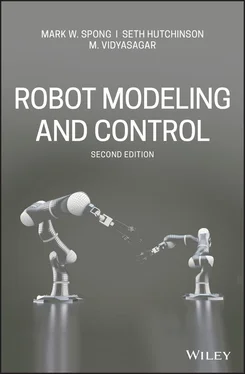

 7.3 Artificial Potential Fields 7.4 Sampling-Based Methods 7.5 Trajectory Planning 7.6 Chapter Summary Problems Notes and References Notes
7.3 Artificial Potential Fields 7.4 Sampling-Based Methods 7.5 Trajectory Planning 7.6 Chapter Summary Problems Notes and References Notes